Chapter 7
The Analytical Task of “Analyzing the Discourse Production around a Subject”
7.1. Introduction
Now let us take a look at a descriptive task which, technically speaking, relies on a class of configurations which can become very complex. This is a descriptive task which is very important, or even crucial in the context of a thematic description* (or description of the content) of an audiovisual text*. It constitutes one of the decisive moments during the analysis in the sense of an expert assessment of the content, i.e. a structured and explicit evaluation of the discursive value of a piece of information (also see [STO 99; STO 01]) – of the way in which a topic is approached in an audiovisual document.
There is a clear difference between the statements that two audiovisual texts making up an analysis corpus speak about a specific archaeological dig – in suchand- such a physical location, devoted to such-and-such an era and with such-andsuch a type of artifact – and how that “same” subject is approached in the two texts. The first statement stems from referential description*; the second from discursive description as such.
This chapter is given over to a brief presentation on the description of the discourse production around a subject. As explained in Chapter 5, this is a question of understanding and explaining how a theme is dealt with by the author or, rather, by its enunciator, i.e. by the person responsible for what is said about a given knowledge object. Just like the referential description of a theme (that is, just like the description of a topical structure), description of discourse production also relies on models of description. These models form part of the category of so-called discursive configurations.
Remember Figure 5.1, which shows that the thematic description (of the content) of a corpus of audiovisual texts relies on explicitation of its thematic structure* (in that sense, we are also speaking of thematic description* here). That thematic structure is made up, on the one hand, of the topical configuration* enabling us to carry out a referential description of the content (analysis of what is being talked about in the text) and, on the other hand, of discursive configurations*, of verbal and/or audiovisual and meta-textual expression. Taking account of the remaining configurations therefore enables us to refine and complement the referential description, depending on the need and the objectives to be fulfilled, with a description of the discourse production (the discursivization [GRE 79]) of the theme(s) concerned, with the description of the modalities and strategies of verbal and audiovisual expressions and also by explicitation of the framework of reference of the analysis itself.
Section 7.2 is given over to a brief summary presentation of the main procedures of discourse production which we have taken into account in conducting our research.
In section 7.3, we shall give a more detailed discussion on the task of describing discourse production around a topic and of its place in the thematic analysis (of the content) of an audiovisual text or corpus.
Section 7.4 is reserved for the presentation of a few concrete examples of the description of discourse production around a topic.
Finally, in section 7.5, we shall develop a few more ideas relating to the subject of the importance of taking account of a discourse analysis (or rather, an analysis of the discourse production around a topic) for monitoring information and, more specifically, for being able to trace the information.
7.2. Procedures of discourse production
The task of describing the discourse production around a topic (also see [STO 01]) relates to the discourse which deals with and “relates to” a subject, depending on its author’s intentions, knowledge of its object and, finally, its audience.
Beyond the fact of determining what a text talks about (referential description* of the subject or theme), this is a question of wishing to detail how a given discourse carried by an audiovisual text or corpus is taken into account. There is a great deal of academic literature on the subject of discourse analysis, and it is difficult to obtain an overall and appropriate view. However, the work of researchers in linguistics, semiotics or pragmatics on discourse and more particularly, discursive strategies for dealing with referential content demonstrate the great advantage which discourse analysis holds for analyzing the content of audiovisual corpora which, when reduced simply to its referential dimension, is often sterile and unsatisfactory.
While we are aware of the great variety and richness of research in the field of discourse analysis, for the moment, we have concentrated on a small set of strategies or so-called procedures of discourse production around a subject. These are presented below in the form of six general questions:
1) Who is the “true” author (i.e. the enunciator) of the subject dealt with and developed in the text? In other words, who is the actual source of the content and who is responsible for it (for its veracity, for instance; its newness or its originality). It is important to be able to answer this question, particularly when it comes to direct or indirect quotes, references to what “someone said” (or rather, may have said), to trains of thought, to texts published or otherwise, and so on, in the context of citations. Explicitizing the structure of the enunciation of the subject dealt with in the audiovisual text is particularly enriching in the context of analyzing interviews, eyewitness accounts, life stories or tales of experiences (see also the explanations we give in [STO 01]). Analyzing the enunciation also includes explicitizing the audience to which the text is addressed. Here, the addressee or the audience is a role which forms part of the discourse (sometimes, this role is also referred to as the enunciatee and is considered a necessary, complementary role to that of the enunciator). In other words, indicators which are apparent within the discourse, or which can be inferred from it, can demonstrate to whom the subject being dealt with by the enunciator is addressed. Taking account of the enunciatee (the target audience of the text) enables us to elucidate two issues which are important for all communication:
– the first issue is evaluating the congruency between the empirical, “realworld” audience of an audiovisual text and the audience at whom that text is actually aimed (i.e. the “ideal audience”, to paraphrase Umberto Eco [ECO 79]);
– the second issue is taking account of the contextual variations of the enunciator’s commitment to the truthfulness, the originality, the exactness, etc. of the subject being dealt with. As we know, these contextual variations may play a crucial role in the construction of the discourse of scientific vulgarization and also in constructing the discourse of a (social) group, of so-called community discourse.
2) What is the point of view according to which the author approaches his/her subject? This second question is closely linked to the first, but raises a different issue. Here, it is a question of a detailed depiction of the (cognitive) position from which the author of an audiovisual text develops his subject. For instance, the author can develop his subject from his own position, which he assumes as it is (he fulfills his obligations both as author and enunciator). However, as we have just seen (see first issue), he may also refer to another enunciator. In this latter case, the author’s attitude towards the other enunciator’s views may vary greatly: from total agreement to extreme opposition, including all the intermediary positions of neutrality, reservation, (see the very instructive research of B.-N. Grunig and R. Grunig [GRU 98] on this subject), etc. It may prove important to explicitly state the author’s position, e.g. in order to understand the opposing points of view on a given subject or, in the context of an interview with a researcher, to differentiate the discourse of the academic and the discourse of the combative character. Indeed, it is not uncommon for the person or persons being interviewed to change their position several times during the same discussion or interview, to a more or less radical extent and without concern for the overall consistency of their discourse.
Thus, for instance, in his role as an expert or specialist on a group or social movement, the researcher can evolve, simultaneously: as an autonomous subject who has (or believes he has) knowledge; as a delegated subject of a higher instance of truth who draws his legitimacy as a scientist or as an expert from belonging to a school of thought or subscribing to a scientific theory; as the holder of convictions who assumes the right to switch from a descriptive discourse to a moralizing discourse; as an empathic subject who adopts the position of the group in order to defend it or attack it; and so on.
3) What is the type or genre of discourse used by the author to develop his subject? It is a question, here (as far as possible), of explicitly stating whether the treatment and development of a subject in an audiovisual corpus takes place, e.g., in the form of descriptions, narrations, explanations or indeed in the form of exposés, testimonies, debates, lessons, ludic mises-en-scène, simulations, etc. Here, one must determine the act which characterizes the discourse the author devotes to the subject. This act may belong either to such-and-such a type of elementary language act identified and discussed in the field of linguistic pragmatics or discourse linguistics [AUS 70; SEA 72], or to a more complex social and cultural genre of discourse or of texts (see, e.g. [ADA 90; ADP 89; STO 01]).
In any case, it is important to take account of this third question, in that it enables us to specify whether a concrete subject is developed in the guise of a narration, of a reasoned exposé, in the form of a series of illustrative examples, or of a dialogical interplay consisting of pedagogically-motivated questions and answers. We can clearly see that the advantage – the added value – of a subject can be very heavily influenced by the type or genre of discourse which “conveys” it: the genre of discourse can mean it lends itself more readily to scientific or expert uses, or, conversely, to educational uses.
4) How does the author (the enunciator) “frame” the referential domain which forms the subject of his discourse? It is a question on the focus of attention which is being asked here – that is, which raises the issue of identifying and explicitizing particular aspects of the object being dealt with in the discourse which the author (enunciator) wishes to bring forward, highlight, prioritize and finally transmit to, share with his audience, and have them accept it. The discursive framework of a topic, similarly to the visual framework, organizes that topic into different specific regions such as the foreground (i.e. the aspects to which the attention of the author or enunciator of the discourse is dedicated) and the background (i.e. all the other aspects which constitute a reservoir which the author-enunciator can exploit throughout his discourse). Another distinction, which is crucial here, is that between the theme and the rheme which plays a central role in the development and progression of the discourse. The theme is the part (or aspect) of the topic which is taken for granted by the author-enunciator of the discourse, and the rheme is that part which forms the argument that the author-enunciator wishes to develop (the rheme is what is considered new for an audience; it is that which the authorenunciator wishes to make his audience understand, and for which he seeks their agreement).
For instance, in two different audiovisual texts which speak about the same person, the information given about that person will not necessarily be identical. To put it very simply, in the first text, the author may concentrate on the social relationships of the person to whom his discourse refers, whereas in the second, the author may concentrate on that same person’s professional career. The same underlying topical structure (the same conceptual model of the referential domain which, here, is the knowledge object “person”) is exploited differently in the two texts. This exploitation consists of choosing the theme or themes which, on the one hand, constitute the foreground of a discourse about a particular person and which, on the other hand, serve the author-enunciator of the discourse to develop his argument, his “message”. Thus, even if two audiovisual texts produce information about the professional career of the same person, the argument (technically speaking, the rheme) may differ greatly: the aspect of the topic “a person’s career” constituting the discursive theme selected in two different discourses, may serve the author of the first text as a theme for developing an argument (a rheme) with moralizing content and serve the author of the second discourse to develop a purely chronological or biographical argument. This is a highly simplified illustration of an otherwise richer textual reality, but which demonstrates what we mean when we speak of the discursive framing. It is the author (the enunciator) who – consciously or otherwise – selects certain aspects (to the detriment of others) of a topical structure to approach his subject in order to fulfill his intention of communication depending on the context of the communication in which he is engaged, and depending on his skills as an author. Taking account of this procedure may help us to better pinpoint the specific place occupied by an audiovisual text or corpus which – grosso modo – deals with the same subject.
5) What is the level of precision (of “granularity”) of the treatment of the subject talked about by the author? While it does not depend upon them, this fifth question is strongly linked to the fourth (the discursive selection of the facets from which to approach a subject) and the sixth (see below, the question of the weighting of the discourse). Specifying the level of precision of a text is a way of assigning it a specific pragmatic position with a corpus of audiovisual texts dealing with the same subject: certain texts may be considered to be specialized texts, others as general texts, and still others as texts whose granularity profile is circumscribed from the referential point of view.
6) How is the subject developed throughout the audiovisual text being analyzed? While it refers back to the fourth question – that of the discursive framing of a topic – this relates more specifically to the question of the logic and strategies of the syntagmatic progression of a theme and its treatment in a given discourse. As we know, the purely linear development of an argument, consisting of adding more and more “new” information to a selected theme, which enrichs it in accordance with the author’s intentions and depending on its audience, is a rather uncommon case.
The development of a theme in his discourse may serve the author as a “pretext” for touching on other themes or subjects; the development itself may take the form of a “more in-depth examination of a domain of reference” but this is only one of many forms of discursive development. For instance, even in so-called scientific discourse, it is not uncommon for the cognitive specialization and enrichment of a given theme to be replaced or “complemented” – a little like in political or didactic discourse – by all kinds of figures of repetition and emphasis (pure and simple repetitions, terminological variations, variations around a given theme, summaries of what has already been said, elaborations, examples serving to demonstrate the interest or the importance of the specific theme, and so on).
In the context of our research on the universe of discourse* of audiovisual archives, we have begun to integrate the problem of describing the discourse production around a topic into the process of analyzing audiovisual corpora. This undoubtedly constitutes a very considerable improvement upon the usual practices of description/indexation of corpora of (digital) texts. The contribution of discourse analysis, we believe, will mainly be felt in the context of information monitoring and in the republication of audiovisual corpora in order to adapt them to specific use contexts.
Figure 7.1. Overall view showing the place of discourse analysis in describing the content of a corpus, and a few of its sub-tasks
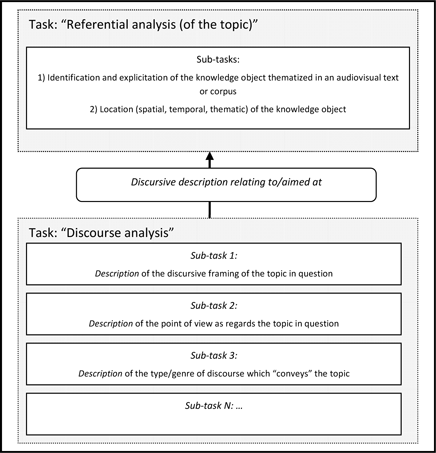
That said, taking account of this stratum in the general structural organization of a text requires real knowledge in discourse analysis, and professional skills which are in scarce supply on the “labor market” because they are not widely taught in establishments which are supposed to train the analysts of corpora (audiovisual or otherwise).
7.3. Anatomy of the description of discourse production around a subject
Figure 7.1 shows how analysis of the discourse production around a subject fits into the process of content analysis. Once the referential description of the domain of reference or expertise has been completed, the analyst may – if he deems it relevant – complement his purely referential analysis of the text’s content with an analysis of the author’s (the enunciator’s) treatment of the subject.
In any case, and as Figure 7.1 shows, description of the discourse production around a topic necessarily presupposes its referential description. Description of the discourse production constitutes a specific task of the thematic analysis of an audiovisual text or corpus, and in itself is made up of a number of more specialized tasks. Figure 7.1 identifies the three following sub-tasks: 1) description of the discursive framing, 2) description of the point of view and finally 3) description of the genre of discourse.
Figure 7.2. The library of sequences for analyzing the universe of discourse of the LHE archive – focus on the specialized collection of sequences “Discourse analysis”
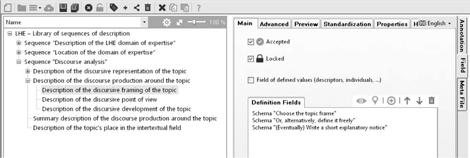
These three sub-tasks correspond to questions 2, 3 and 4 identified above (section 7.2). They have been defined and implemented as part of the ASW-HSS project (see [LEM 11a]) along with other sub-tasks peculiar to discourse analysis. These sub-tasks form a small library of specialized sequences integrated into the library of analytical sequences available to the analyst of a given archive. Remember that a sequence* constitutes a building block* of a model of description of an audiovisual text or corpus. Here, these are sequences which are functionally specialized in analyzing the discourse production around a topic.
Figure 7.2 specifically shows the library of sequences “Discourse analysis”, reserved for analyzing the universe of discourse of the LHE archive developed as part of the ASW-HSS project and coordinated by Muriel Chemouny [CHE 11a].1 A specific sub-task of discourse analysis corresponds, in simple cases, to a sequence. Certain sub-tasks, however, require the use of several sequences in conjunction. As the example of Description of the discursive framing of the topic (Figure 7.2) shows, a sequence defining a sub-task (or a part of a sub-task) of discourse analysis is itself made up of one or more conceptual schemas (remember that a conceptual schema* is made up of one or more conceptual terms forming part of the ASW metalexicon2). As regards our example, three schemas define the sequence Description of the discursive framing of the topic. These are:
– the schema Choose the topic frame: this schema offers the analyst a specialized micro-thesaurus, a list of predefined discursive frames, from which he chooses the one which most closely resembles the discursive frame employed in the text being analyzed;
– the schema Or, alternatively, define it freely: this schema offers the analyst the chance to freely define the discursive frame according to which the subject is dealt with;
– and finally the schema Write a short explanatory notice: this schema enables the analyst to add an explanatory remark.
It should be specified that the – highly modular – definition of the sequence Description of the discursive framing of the subject may be adapted to the context and specificity of the universe of discourse of an audiovisual archive. In other words, the three schemas used to define the sequence Description of the discursive framing of the topic in the context of analyzing audiovisual texts for the LHE archive, may – in the context of an analysis of audiovisual texts making up another archive – be partially replaced by other schemas, or indeed complemented by schemas which are not shown here. In addition, the definition of this-or-that relevant conceptual schema, or even the definition of the specialized micro-thesaurus(es) used in the above sequence which we are using as an example, may vary from one archive to another, i.e. from the analysis of one universe of discourse to another.
This example demonstrates how adaptable the modular approach put forward here is, to give an account both of the intrinsic specificity of a given audiovisual corpus and of the particular expectations which potential audiences will have of the same corpus.
7.4. Examples illustrating analysis of discourse production
Figure 7.3. The sequence reserved for discursive description of the topic “Authors of French literature in the 18th Century”
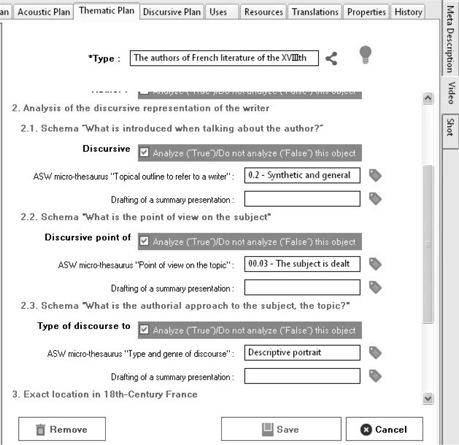
A fairly simple way to take account of the discourse dedicated to a specific subject is presented in Figure 3.6. The figure shows us an extract from the interface of a model of description of audiovisual corpora which forms the CCA archives3, coordinated by Elisabeth de Pablo [DEP 11c]. The analyst may, if he so desires, refine his purely referential analysis (relating to the technical culture of the Chavín civilization, a pre-Colombian civilization) with a discourse analysis, which in our case, manifests itself in the form of two specialized sub-tasks:
– the sub-task Discursive thematization, and
– the sub-task Discursive point of view.
Each of these two sub-tasks can be carried out easily by selecting one or more appropriate values in the corresponding micro-thesauruses, integrated into their respective working interfaces (see Figure 3.6).
Figure 7.4. Extract of the micro-thesaurus devoted to the analysis of the point of view as regards the subject thematized in an audiovisual text
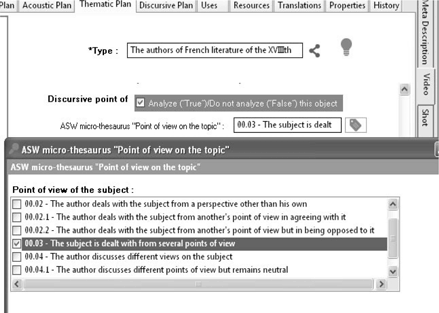
Figure 7.3 shows another example of analysis of discourse production around a topic. It represents the working interface of a model devoted to the description of audiovisual corpora which “speak” about authors of French literature in the 18th Century. This model forms part of the library of models of the LHE archives4, coordinated by Muriel Chemouny [CHE 11a]. In contrast to the example shown in Figure 3.6, and also to that shown in Figure 7.2, the sequence, here, encompasses three specialized sub-tasks in discourse analysis. This time, we do not use one sequence per specialized task in discourse analysis (or various sequences for the same specialized task) but rather, a single sequence including all the specialized sub-tasks. The advantage, of course, is a saving both in terms of design efforts and of the time having to be invested in developing and monitoring a library of such analytical models. In this case, for all the texts making up the collection of an archive, we use one and only one sequence to describe the discourse production around a topic.
Figure 7.5. Extract from the micro-thesaurus devoted to the analysis of the type or genre of discourse chosen by the author to develop his subject
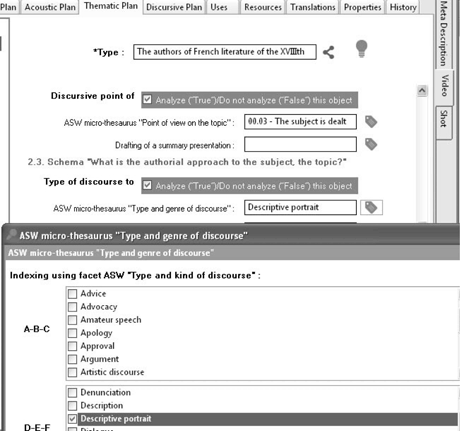
The sequence given over to analysis of the discourse developed in the audiovisual texts which make up the collection of the LHE archives indeed encompasses three specialized sub-tasks:
1. analysis of the discursive thematization of the topic Author (of 18th Century French literature). Here, it is a question of specifying the facet or facets, the aspect(s) which are brought to the fore in an audiovisual text to speak about, describe, present, etc. a writer;
2. analysis of the point of view adopted by the author of the discourse to speak about an author of 18th Century French literature. With this task, the analyst may – if he so desires and if it is applicable – specify whether the information produced about a writer in an audiovisual text comes from the author of that text, from another source (cited by the text’s author), from several other sources, and so on; and finally,
3. analysis of the genre or type of discourse chosen by the author of the discourse to speak about “his” writer. With this sub-task, the analyst can further specify whether the information produced relating to a writer is provided in the form of narration, description, a series of examples, testimonies, etc.
The procedure of description as such to “technically” carry out one or other of the three sub-tasks is, again, fairly simple. The performance of each of the three subtasks relies on a procedure of controlled description*, i.e. on the use of specialized micro-thesauruses which offer the analyst the chance to choose one or several appropriate values to expand upon the conceptual term defining a “strategy” of discourse production.
Thus, in our example (Figure 7.3), the analyst signals the point of view according to which the subject <Technical culture of the Chavín civilization in the 4th Century B.C.> is treated in his text. Using the appropriate micro-thesaurus to explicitize that strategy of discourse production, the analyst selects the statement <The subject is dealt with from several points of view> (Figure 7.4). If the analyst wishes to further refine his description, e.g. by explicitizing each of the different points of view or the author’s position as regards these different points of view, he can also add a short explanatory note (Figure 7.3).
It is plain to see that we are nearing one of the current limits of our approach to description, namely that of not being able to produce a meta-linguistic framework which is capable of further structuring and explicitizing the identity of a point of view, the “orchestration” between different points of view, the possible relationships between the author of the discourse and the different points of view he solicits, etc.
Finally, Figure 7.5 shows an extract from the micro-thesaurus made available to the analyst in order to allow him to explicitize the type or genre of discourse employed by the author to develop his subject. In our case, the analyst has ticked the genre <Narration> and the description genre <Descriptive portrait>, thereby indicating that the subject, <Technical culture of the Chavín civilization…> is developed in the form of a recounted story (here, chronological) and a description (a “portrait”) showing the most salient aspects of the technical culture of this civilization.
Here, we see another limit of our approach to the description of audiovisual corpora, which lies in the fact of not being able to offer the analyst the option of providing information about the actual structural organization of a narrative or a portrait [ADA 90; ADP 89] such as it manifests itself in such-and-such a passage of an audiovisual text. It is one thing to identify an audiovisual passage as being a narrative or a portrait; it is quite another to explicitize their characteristic peculiarities.
7.5. Textual and discursive assessment
The approach to the description of audiovisual corpora presented herein undeniably has a series of limitations, particularly in terms of taking into account the linguistic and semiotic specificity of the discourse, which is a highly active and innovative field of research, both in France, the United States and elsewhere (see e.g. [CHA 02; GRU 98; MAI 96; SAR 07]).
The taking into account of the results of this research and their (at least partial) integration into the ASW metalinguistic resources depends on the theoretical compatibility between these different contributions (and compatibility with the approach presented here) and on the opportunity, the “advantage” of proceeding in this manner. In concrete terms, this adaptation will manifest itself in the form of the setting up of a far larger library of sequences and schemas of description specialized in discourse analysis (a library of sequences very similar to that shown in Figure 7.2) – a library of sequences and schemas which would take account of the limits set out above and of the possible solutions put forward in specialized research about the function of discourse.
The advantage of creating such a library of sequences and schemas specialized in discourse analysis brings us back to the question of more specialized genres or types of information assessments:
– assessments which content themselves with analyzing the purely referential content of a corpus of (audiovisual) texts; or
– assessments which also take account of the discourse and the different strategies of discourse production around a piece of information (see above, section 7.2).
Let us note, in passing, that one of the most central issues in the current economy of knowledge is that of the traceability of information (in the context where traceability has a particular connotation of reliability). However, this is simply impossible to put in place without taking account of the discourse of the author of a piece of information (new, repeated, cited, reworked, etc.).
As we well know, it is not the quantity of information available (in a library, an archive, on the Web, on the various social networks, etc.) which poses a problem – quite the contrary in fact, – but rather the reliability, the quality or the added value of a piece of information for a given audience. Discourse analysis alone will not solve this question which is crucially important for all disciplines of “knowledge”, but without it, the question can never be solved.
1 Remember, LHE constitutes one of the three major experimental domains of the R&D project ASW-HSS (financed by the French ANR for the period of 2009 to 2011). It deals with the description and diffusion of audiovisual data concerning literature and history of literature (see http://semiolive.ext.msh-paris.fr/alia/).
2 A detailed presentation of the ASW meta-lexicon is offered in Chapters 11, 12 and 13 of this book.
